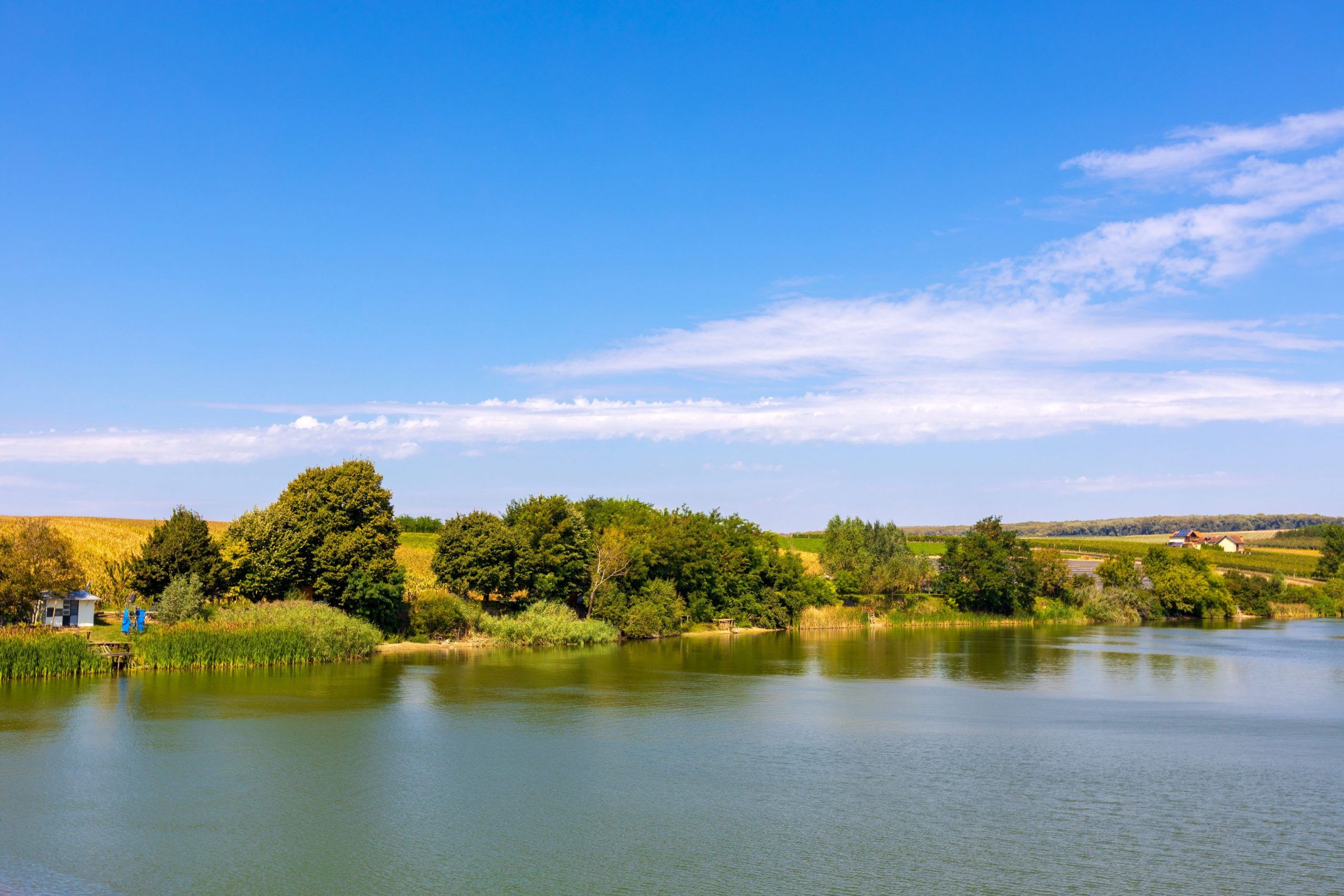Susek – Neštin – Erdevik – Šid – Bikić Do
The western part of Fruška Gora, between the Danube in the north and the border with Croatia in the west, abounds in natural beauties and monumental heritage, among which we could single out forest areas with Erdevik hunting ground Vorovo, lakes Moharač, Bruje and Sot, and man-made heritage where Serbian Orthodox monasteries of Đipša, Petkovica, Kuveždin and Šišatovac stand out. This is also a recognized wine-growing region known for the fact that this is where the vineyards and wine cellars of the Italian aristocratic family Odeskalki were located. Traces of the Odeskalki family are still visible today, whether it is about memory, tradition or material testimonies of their Srem wine experience.
Many winemakers will refer to the fact that modern vineyards are located exactly where those of Odeskalki’s, and in some places there will be masterfully designed and built wine cellars, and the wine villa with the Bikić Do park, which all together reminds of a former beauty and wealth of the privileged nobility being the main reason for forming of special settlements of winegrowers inhabited by those who created that beauty and wealth. Such settlements are Bikić Do and Stara Bingula.
On the slopes of western Fruška Gora today there are more and more vineyards and excellent wines made from the following assortment of grapes[1]: Italian Riesling, Rhine Riesling, Chardonnay, Sauvignon White, Traminer, Pinot Gris, Merlot, Muscat Hamburg, Cabernet Sauvignon, Vranac, Tamjanika, Shiraz, Frankovka, Pinot Red, Probus, Marselan, etc. Berkasovo is the host of the traditional “Sremska vinijada”, which has been organized for two decades in this Srem place where wine producers gather every February to exchange experiences and evaluate wines.
Susek is a Danube village in the Municipality of Beočin. In the Roman period, there was a watchtower on the place where the modern settlement is located, and in the Middle Ages, there was also a fortification mentioned in 1445. During the period of Ottoman rule, the military significance of the settlement disappeared. The Serbian population immigrated here en masse during the Great Migration of the Serbs in 1690. In the 18th century, the striking Baroque Church of St. Archangel Gabriel was built, with the iconostasis painted by Teodor Dimitrijević Kračun. The old iconostasis was painted over in 1901. Today, Susek is a place known for cattle breeding and production of goat cheeses. The construction of the embankment on the marsh land created the Ribnjak “Susek” (“Susek” Fishpond). Dudan Winery is also in the settlement.
Neštin is a Danube settlement in the Municipality of Bačka Palanka, on the border with the Republic of Croatia. At the entrance to the settlement, there are two monuments, the most impressive of which is the work of Jovan Soldatović dedicated to the fallen fighters of the National Liberation War and the victims of fascist terror, and the more modest to the Navy Company. Archaeological findings show that people have lived here since prehistoric times, that there was a fortification during the Roman and Hungarian rule, and that the Ottoman administration registered the existence of a village without military functions. In the 18th century, the impressive Serbian Orthodox Church of St. Cosmas and Damian, which houses the iconostasis, the work of one of the greatest Serbian baroque painters, Teodor Dimitrijević Kračun. The carving of the iconostasis is the work of Marko Gavrilović, and the celebration icons in the choir of Stefan Gavrilović. On the hill there is the Roman Catholic Church of St. Anne from the 19th century. Neštin also keeps another valuable, an old house from the 18th century, a rare example of folk architecture. In the settlement there are the wineries Tri međe i oblak Winery and Gaston Wine Winery which are definitely worth visiting.
Šid is a small town in Srem, the seat of the municipality of the same name, built according to all the rules of the planned constructional development in the 18th century. The most significant attractions of this town include: the Serbian Orthodox Church of St. Nicholas from the 18th century with a very valuable baroque iconostasis, thrones and furniture, “Sava Šumanović” Gallery where an opus of 417 paintings by one of the most important Serbian painters is kept, near which is the painter’s house open to visitors, and the Museum of Naive Art “Ilijanum”, which keeps the works of Ilija Bašičević-Bosilj, one of our most important naive painters. The following wineries are located in Šid: Trivanović Winery, Wine Cellar Danguba Winery and Molovin Winery.
Erdevik is an old settlement that has been mentioned in historical sources since the middle of the 14th century. The modern layout of the streets and houses is a consequence of the planned construction from the 18th century, which makes the settlement one of the most arranged, but also the most beautiful in Srem. The most significant attractions in the town include: the Serbian Orthodox Church of St. Nicholas with a valuable iconostasis and the Roman Catholic Church of St. Michael with an altar made in the manner of Tyrolean churches, and the Slovak Evangelical Church A.V. The Erdevik region is rich in natural attractions, among which the Moharač and Bruje lakes are important for tourism.
The fact that the town was the centre of wine production is also evidenced by the fact that Count Livije Odeskalki founded a wine cellar there in 1826. You can explore the offer of Erdevik wines by visiting Vinat Winery, Erdevik Winery and Salaš Farmstead – Wine House Brestovački.
The villages of Berkasovo and Bikić Do are located on the road Šid – Ilok. In Berkasovo there are the remains of the medieval fortress Castrum Berekszo, popularly known as Despotovac, which is known to have been in the possession of the despot Vuk Grgurević (Zmaj Ognjeni Vuk) in the 15th century. The fort was destroyed by the Turks, and the Roman Catholic church in Kukujevci was largely built of that material. Of great importance are the Serbian Orthodox Church of St. Peter and Paul in Berkasovo from the 18th century. The rich baroque-rococo iconostasis is the work of an unknown master, and the frescoes are the work of Pavle Čortanović from the beginning of the 19th century.
Bikić Do is a young settlement that was formed during the 19th century, first as a wine-growing village, and later the houses were grouped along the Šid-Ilok road. One of the Odeskalki wine cellars from 1826 is located in this place. The Lake Sot, surrounded by forests of the Vorovo Hunting Ground is nearby, as well as the Lipovača picnic area. Privina Glava Monastery is two kilometers away from Bikić Do. The legend says that it is the oldest monastery at Fruška Gora, which was built by the Serbian nobleman Priba in the 12th century. The church of the monastery is dedicated to St. Archangels Michael and Gabriel. It is known that it was renovated in the 15th century, and the renovation is related to the Brankovićs from Srem.
It is also known that the monastery was destroyed during the Austro-Turkish wars and that the new church was built in 1760. The wall paintings were made by Kuzman Kolarić, and the iconostasis is attributed to Andrej Šaltista. In Bikić Do there is Ilić-Nijemčević Winery, which is definitely worth a visit.
Another cultural monument of exceptional value is nearby. It is the Serbian Orthodox Church of St. Archangel Gabriel in Molovin. It was built in 1801 on the site of an older temple from the 18th century. The carvings of the iconostasis from the 18th century and the iconostasis by Jovan Četirević Grabovan are of great value.
For more information about Šid and surroundings visit: https://www.tourismsid.rs/
Text: Gordana Stojaković
Photographs: Aleksandar Milutinović
Tourism Organisation of the City of Novi Sad is not responsible for changes in information and services.
The text posted in: September 2021
[1] Transcription of the grape assortment names is given according to: Cindrić, Petar and Vladimir Kovač (2007) “Vinogradarstvo i vina“ (“Viticulture and Wines“) Fruška Gora. Ed. Nebojša Jovanović and Jelica Nedić. Pg. 498. Beograd: Zavod za udžbenike



